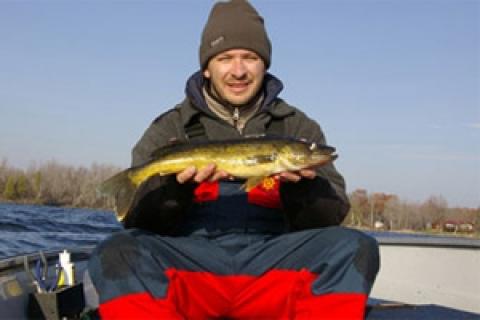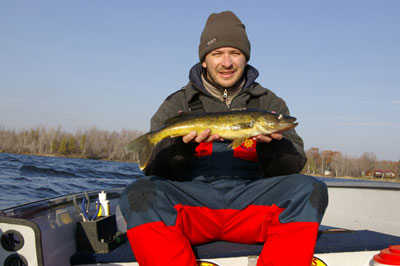
Presentation is a key component when chasing walleye. If your lure or bait is not positioned at the correct angle, depth or speed, your chances for success are greatly diminished.
 |
| Boat control is imperative when chasing walleye. Baits must run at the correct speed when trolled for proper action. |
Boat control is your greatest asset when it comes to presenting your bait accurately, yet it is a skill that requires the necessary equipment, as well as time spent on the water practicing. Follow these tactics to better your boat positioning, and reap the rewards of more walleye in the net.
The Art of Trolling
The majority of anglers troll in a forward motion, which is an excellent option if the boat is rigged with a small horsepower outboard, or if the fish are in an aggressive mode. The problem lies in the fact that larger outboards tend to troll too quickly, causing baits to run untrue, and generally far too fast for walleye.
Back trolling allows the boat to troll at slower speeds (upwards of 30 percent), while also producing enhanced cornering and greater control. The slower speeds enable anglers to toss lighter lures, creating a finesse factor for finicky fish. A tiller motor is the preferred style of engine when back trolling, as steering in reverse is best accomplished from the rear of the boat. If large waves continually get you wet, affixing splash guards to the transom can be a quick and easy solution.
For those without a tiller or small kicker motor, a trolling plate can be attached to the big engine to slow things down. These plates act like a brake when positioned vertically, and as a stabilizer when up. Trolling plates are designed for forward trolling only, and are an excellent option to significantly decrease speed.
When fish require an ultra slow presentation, an electric trolling motor can be your greatest asset. Position the speed on the lowest setting, and work the water inch by inch. This is an excellent technique for working large
weed flats, or when following the contours of a weed line. Not only will your speed be turtle pace, but will also be whisper quiet, lessening the chance of spooking any fish along the way.
Using Wind and Waves to Your Advantage
 |
| When the winds really howl (as can be seen in the size of waves in this shot), reliance on a drift sock is mandatory. |
The wind can be your greatest gift when it comes to boat control, but knowing how to work with it is the name of the game.
Drifting with the wind can be an excellent tactic when covering large expansive flats, or as an alternative to spooking fish in very shallow water. Drifting can cover water quickly, and can often be your best bet when waves and wind are on the heavy side of things.
Use your outboard motor as a rudder. This will allow you to make slight alterations to your course while drifting along. It is also important to evenly balance your boat in regards to weight. When weight is distributed correctly, a boat will drift better, especially when battling high winds.
If the drift rate becomes too quick for your desired presentation, use a drift sock (or a combination), to slow things down. These socks take up little room in the boat, and are worth their weight in gold when the wind really howls. Experimentation is key to working drift socks correctly, as the style and draft of boat, size of sock and strength of wind all factor in. Two from the stern, one from the stern, or a combination of bow and stern are recommended areas for placement. If utilizing the bow and stern, choose a larger sock for the bow, as the wind will push this area more easily than the stern.
Marker Buoys
Marker buoys are one of the most underutilized tools in fishing today. If truth were known, they may be one of the most beneficial. These inexpensive "beacons" allow you to determine where your boat should be positioned, keeping you on the correct course in terms of structure and fish.
Used in conjunction with sonar or GPS, marker buoys allow you to keep in direct contact with marked fish or previously productive areas. They are also helpful in plotting irregular weedlines, or the tops of humps or points.
I always toss one out when a fish is caught, as where there is one often equates to more. By doing so, I am able to pound the area thoroughly, while hopefully scraping up an additional fish or two.
 |
|
| The author works a small submerged rock pile in this shot. An anchor was used off the stern to stay directly over top of structure area. |
There are three main styles of markers, including the Barbell, H-Style and Stand-Up. Stand-Up markers are an excellent choice when dealing with high and rolling waves and are also the best choice for night fishing. Keep a few on board and get into the habit of using them — they will definitely pay off.
Anchors
When precise, stationary boat placement is necessary, an anchor will often be your best friend. Certain situations may arise in the walleye game when staying directly on top of structure or fish is paramount for success. Small and isolated humps, breaklines and points are such scenarios.
There are a multitude of anchors on the market, yet the amount of rope you let out will often be the deciding factor in terms of staying put. It is imperative to use enough rope in order to get the needed angle for an anchor to bite and hold steady. Go with a rope at least three times longer than the greatest depth you will be targeting. This will cover all of the bases. Weight is a primary consideration, but is not the deciding factor. Your local marina will be best able to recommend the correct weight and style of anchor to complement your boat and style of fishing.
If you still deal with drifting when anchored, try the two weight system — an anchor off the bow and one from the stern. This should hold you tight.
Boat control is an important consideration when targeting walleye. These fish can be finicky when it comes to speed and bait placement, meaning the more accurately you can offer them what they want, the better your chances for success. Keep a close eye on your boat control this season — the fish may not thank you, but the landing net certainly will.
- 6300 views

